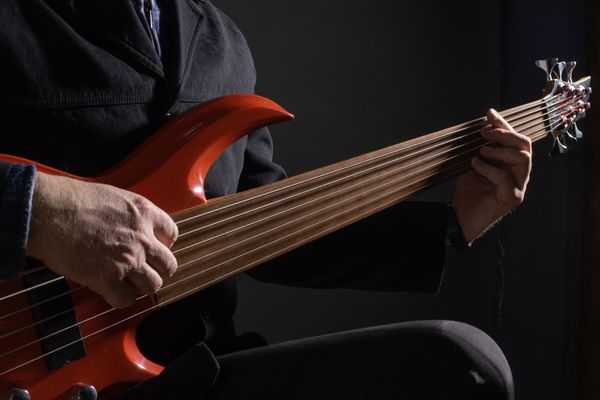
The electric bass evolved from the upright version, keeping the same string names, range and intervals but with a more portable form for jazz and rock playing.
On the other hand, the bass has proven to be more than just a rhythm instrument. Advances in design, including five and six-string electric basses and the Bass VI make this possible.
The technique for playing a six-string bass varies from a four-string bass, so beginners are recommended to start with a traditional four-string until their technique improves. As you grow as a player, consider the following factors for transitioning to a six-string bass.
What Is a Six-String Bass?
Six-string basses have two extra strings: a low B, which extends the range down a fourth and a high C, which eliminates having to travel up the fretboard to hit certain notes. It also changes the instrument’s melodic possibilities. This combination reduces the amount of shifting and reaching, so you can play chords with relative ease.
Popularity surged in the 1970s and 1980s, as keyboards began to assume some rhythm elements in rock and New Wave bands. Today, bass players looking to take on a more melodic role and perform more solos often reach for a six-string.
The six-string bass should not be confused with the Bass VI, an electric bass tuned with the same intervals as a guitar. The Bass VI is also not the same as a baritone guitar, a traditional electric guitar tuned to hit a lower range.
Technique
As the most significant difference, six-string basses situate the strings closer together on a wider, thicker neck. Players attempting a six-string for the first time have to get used to working in a narrower space and controlling the sound. To this latter point, you may initially find that your pick or fingers are hitting other strings.
Yet once you master this, you’ll have an easier time playing melodies. Notes are ideally spaced for chords and sound less muddy when you attempt more polyphonic music. That being said, you’re recommended to try out some six-string basses to gauge your comfort level and see what works for you.
Greater Range
The two extra strings allowing you to hit higher notes provide the following possibilities:
- Better Chord Voicing: If you’re looking to play more chords, the lower and higher strings let you space out notes to create more resonate, complete combinations.
- Hitting Lower Notes: To access a lower range, bass players tend to have two choices: tune down their four-string bass or use a five or six-string. If your music spans a wider range, the lower B string lets you pluck these notes and reach for higher pitches.
- More Melody: While four-string basses tend to suit rhythmic, groove-style playing, the ‘70s and ‘80s proved that the electric bass could work as a melodic instrument. Yet unlike a guitar, it produces a deeper, richer sound for such melodic lines. Having the extra C string helps these notes emerge during these moments and eliminates having to routinely play farther down the fretboard.
Playing Chords
On a four-string bass, the voicing is tight and strictly within a low range, so the combination may not resonate as expected. Using the low B and high C strings expands the range and voicing, allowing for more definition.
However, the six-string bass is not meant to be played like a guitar – it spans both rhythm and melodic opportunities. By contrast, the Bass VI is voiced to be played more like a traditional electric guitar in a lower, deeper range.
Are you ready to start playing the bass? Explore electric options at DuBaldo Music Center and sign up for lessons! Contact us to learn more.
